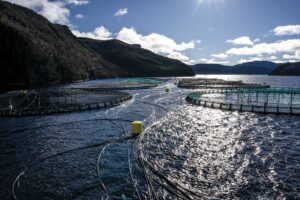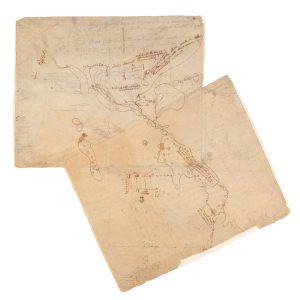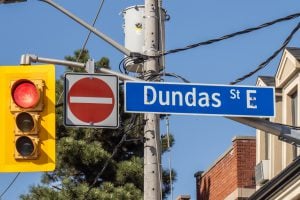
People & Culture
Kahkiihtwaam ee-pee-kiiweehtataahk: Bringing it back home again
The story of how a critically endangered Indigenous language can be saved
- 6310 words
- 26 minutes
People & Culture
Author John Vaillant on his new book Fire Weather — and the toxic relationship between fire and petroleum

In the early days of May 2016, the city of Fort McMurray, in northern Alberta’s subarctic boreal forest, was on fire. As temperatures rise and the winter snowpack starts to melt, wildfire season can kick off as early as spring in the province. But this was no ordinary fire. Gaining traction and power in a matter of hours, the fire overtook the entire city, forcing nearly 100,000 people to evacuate as their houses, cars, possessions and livelihoods burned to the ground before their eyes. The single costliest environmental disaster in Canada’s history, the fire was a frightening example of what B.C.-based journalist and author John Vaillant calls our new “century of fire.”
In his latest book, Fire Weather: The Making of a Beast, Vaillant argues that our obsession with petroleum and fossil fuel extraction has led to a deadly new 21st century reality ruled by fire — in a form we have not previously experienced. As climate change has given rise to a world governed by hotter, drier conditions, human life and the natural environment are increasingly at the mercy of the elements. Focusing on the Fort McMurray catastrophe as an example of the fateful dynamic between intensified fires and resource extraction, Vaillant digs deep into the events of May 2016 to expose the true costs of this relationship. With Alberta experiencing another devastating wildfire season, and B.C. in the midst of a record-breaking spring heatwave, Vaillant spoke with Canadian Geographic about his book’s relevance.

I came to the Fort McMurray fire like so many millions of people around the world — just seeing the footage on the news and coming in over Twitter: this major city completely disappearing under a pyrocumulonimbus cloud. Then there was the uncertainty that all of us felt for days after: “What’s under there, Who’s under there? What’s happening? Will there be anything left?” That all wasn’t known for several days. I found that really frightening. Then, as I started to think about it more as story — I’m a journalist and writer and am interested in climate and environment, but particularly in collisions between human ambition and the natural world, which Fort McMurray has in spades — I started to think about it as a potential story to write.
I was out of town at the time; I’m far away from Alberta. You could see journalists swarming, and rightly so: it was a very big story and remains one. I thought, “Well, books are going to be written about this, and maybe there’s a place for me in there.” Then I started thinking about it more and started to see a deeper link, when I looked at the weather preceding the fire and saw that they’d had frost within a week. Many lakes were still frozen. There were huge blocks of ice the size of cars along the banks of the Athabasca River. I thought, “Wow, you know, if a fire can burn with that intensity, with winter barely over and that far north, what could it do in Vancouver, where I live, in a part of the city that’s filled with 100-year-old houses made of wood?” It’s getting hotter everywhere. It’s getting drier in many places. So I thought: okay, this wasn’t just an anomaly. This is an indicator: this fire’s a bellwether. And when I started thinking about it like that, and its implications for the future, I realized that this fire potentially had a lot to teach us, collectively, not just as Western Canadians or North Americans, but as inhabitants of the 21st century.
After the Fort McMurray fire, I started thinking about fossil fuels and bitumen and oil. What do these things really do? And what they really do is burn. That’s why we’re interested in them. That’s the only reason we devote so much energy — mental, physical, technical — to extracting these substances from the ground, whether it’s coal, bitumen, oil or gas. We want to burn. We call it energy or fossil fuels, but what if we just called it by its real name, which is fire? We live in a fire-powered civilization. And to fuel it, it requires a massive recovery of hydrocarbons every day. And the burning of those hydrocarbons in massive quantities every day.
Thinking about it like that, the climate impacts became somehow more vivid and accessible. I’m looking up at the sky right now and it’s crystal clear, unseasonably hot. It’s way hotter than it should be here in Vancouver, but it feels beautiful. The flowers are blooming. But all that CO2, all those emissions, go somewhere. And they don’t just go away; they go into our atmosphere.
I started thinking about the amount of fossil fuel that’s required simply to liberate the bitumen in Fort McMurray. And then, what that bitumen is ultimately rendered into, with more massive energy expenditures of natural gas, to try to turn it back into a usable fuel. I thought this, combined with the fire, offered a useful way, a graphic way, to understand some important dynamics that are shaping our future and that are really going to determine how livable it is. Because that’s what’s being determined right now: how livable our world is going to be.

Fire weather, at any time in history, is the dynamic relationship between air temperature, relative humidity, and the moisture content of local fuels. That could be how dry or wet the trees are, how damp or dry the forest floor is, how dry the forest litter is, or if the fallen trees in the forest are bone-dry or soggy with rain. Fire weather is also a reference to the fire weather index. In Canada, it’s used as a way to measure and quantify all these factors. Right now, for example, in May, all across the Canadian West, the fire weather index is extremely high.

Why fire weather really caught my attention as a concept, and ultimately became the book’s title, is because I feel like we’re entering a period of enhanced and more dominant fire weather. Temperatures are universally higher. As the temperatures rise, you have more evaporation. It’s just basic physics. In the boreal forest, which is historically the wettest biome on Earth, if you heat it up, say into the mid 30s, day after day after day, a lot of that water and a lot of those muskeg bogs are going to evaporate. I’ve talked to firefighters who told me that muskeg bogs in the Canadian boreal forests are dry to a depth of more than two metres. Bone-dry. Those muskegs turn into fuel when they dry out. It’s a very potent fuel source and it’ll burn all winter. Fire weather feels relevant to me now because we’ve gotten more of it, it’s more intense, and we’re seeing types of combustion that really nobody has experienced before. At least not prior to 2000. It was an extreme rarity, and things like full-on fire tornadoes — the first of which was in Australia in 2003 and the second in Redding, California in 2018 — these are new under the sun. No one’s ever heard of that before. And I’m talking about a proper tornado, an EF3 [Enhanced Fujita Scale, an index measuring a tornado’s intensity], blow-your-house-away tornado, coming out of a fire. That’s new under the sun. And that’s a world, that’s a climate, that’s fire weather, that we made. That our obsession with fire and hydrocarbons has engineered.
I think people are much more ready to evacuate early now, in a timely fashion, than they were in 2016. There’s no doubt in my mind that if we knew what we know now, Fort McMurray would have been evacuated on May 1 or May 2, not on the afternoon of May 3, with the fire already in the city. So now you see all these pre-emptive evacuations. They’re traumatic in their way, and hugely inconvenient, but it’s better, believe me, than trying to escape through fire. It’s better than seeing your house burned down in front of your eyes. It’s better than calling your loved ones to say, “I don’t know if I’m going to make it out of this.” There were a lot of those calls in Fort McMurray on May 3. It’s traumatizing. It leaves a mark that lasts. So, pre-emptive evacuations are something we’ve learned. That’s going to be very helpful in terms of saving lives, certainly, but also in reducing psychological trauma. What I don’t think we’ve learned is to meaningfully connect our dependence on — really, our captivity by — the fossil fuel industry to its impacts on our climate. That is a really difficult nut for Canada to crack. We’re a major oil producer and a major fossil fuel exporter. And it’s toxic to us.
We’re a major oil producer and a major fossil fuel exporter. And it’s toxic to us.
In Fort McMurray, I didn’t know anybody when I went there. I was a total stranger. And Alberta is generally a pretty conservative place. Fort McMurray has really been beat up on by environmentalists. And there I was, a lefty, liberal guy coming from Vancouver. But I told them what I was up to, that I was writing a book about the fire, and people were — to a man and to a woman — generous and candid and helpful. It’s thanks to them that the book has whatever power it has, because I wasn’t there for the fire; they put me there, they took me there, with their reflections on what was for many the worst day of their lives. The fact that they revisited that with me, basically a stranger, was incredibly moving. That’s one of the strange and wonderful privileges of being a journalist: spending time with people who are willing to share this kind of information with you. It’s a trust that I take very seriously. I hope, fervently, that I’ve done justice to the citizens and first responders of Fort McMurray.
The other thing, just on the kind of raw, physical, experiential level, was when I went to Redding, California, only a few weeks after the fire tornado had gone through that neighbourhood [in July 2018]. I’ve never seen things broken, destroyed, erased from the planet like that. It was unbelievable. And the fact that it came out of a fire — nobody bombed it, there was no petroleum directly involved, nobody dropped a nuke on it. But the destruction was total. Think about what it takes to take a cast iron frying pan, throw it hundreds of metres from the nearest house, break the handle off and punch a hole through the bottom and think about what it’s going through on that journey to make that happen. It was all just fire. To do that with heavy metal tools would really take some doing and this was purely atmospheric energy that did that. It tore cars in half. The houses were simply gone. There was nothing left but concrete slabs. There was no grass, no glass; the tree bark was gone. Everything was just burned and scoured off. And that shocked me. That left a scar on my eye that I will never forget.
We’re already doing it now. Take Paris. I remember being there when I was a kid and pollution of two-stroke engines and diesel was appalling, the noise was appalling, the traffic was insane. And now, Paris is, probably of almost any major city, accommodating and converting to two-wheeled electric and cycle transportation with incredible speed. That makes a huge difference, not just to quality of daily life, and what can be the joy of urban living, but also to the atmosphere — of slow-moving idling cars off-gassing day in and day out. Likewise, there’s also this incredible push to shift to renewable energy that China is driving. Another really amazing example of not just learning but actually acting is that India has declared it will build no new coal-fired power generation plants. Given the size of India, given the number of people they have — the largest population of any nation in the world now — them making a decision like that represents a planetary change. It’s huge. Unthinkable a decade ago.
So, we’re making massive strides right now. We are absolutely learning. Frankly, Canada is at the back of the line in getting the message. Canada, I think of any nation on Earth, has the capacity and resources to benefit hugely from a renewable energy supply. We have everything. We have the sun, we have the wind, we have the tides, we have the rivers, we have geothermal. And we have a small population relative to the size of the territory. Stephen Harper used to talk about Canada being an energy superpower. And he was talking about bitumen, he was talking about oil. Well, Canada does have the potential to be an energy superpower, but a green energy, a renewable energy. It’s overhead and under our feet, waiting to be tapped, and really will not be possible until we come to terms with our dependence on and captivity to the petroleum industry.
When you stop burning things, other things will grow in their place.
The term revirescence, which I use in the book, is the resurgence, the recovery, of life. That was so profound when people finally returned to Fort McMurray, which was the longest-uninhabited city in North America after New Orleans post-Katrina. People came back and they hadn’t been home in a month, they hadn’t been home in six weeks. The fire had burned all the way through their neighbourhoods, destroyed everything. And yet their lawns were neon green. And the flowers were blooming in gardens that no longer had a house in front of them. It was surreal. But it was also this reminder that the life force, the greening energy of the world —another term from the book, viriditas — is incredibly potent, and really unstoppable. For me, after writing and, you know, spending so much time in this really dark and frightening and dire place of the 21st century — a world that still derives 80 per cent of its energy from hydrocarbons and directly from burning — I feel it’s important to remember that the Earth is powerful and resilient. When you stop killing things they grow back, generally speaking, if you don’t render them extinct. When you stop burning things, other things will grow in their place. The natural instinct, the natural impulse, on the planet Earth is to grow and to flourish. That’s what fire does, and that’s what humans do, too. It’s an extraordinary place where we live, that it encourages growth as generously as it does. But we need to give it a chance. And what’s really clear right now is that burning hydrocarbons at the rate that we burn them is counterproductive to the objectives and needs and natural tendencies of planet Earth: to grow and regenerate and be healthy.
Are you passionate about Canadian geography?
You can support Canadian Geographic in 3 ways:

People & Culture
The story of how a critically endangered Indigenous language can be saved

Environment
Struggle and success in Atlantic Canada, where aquaculturists strive to overcome climate change and contamination while chasing a sustainable carbon footprint

People & Culture
*It means “awake” in Beothuk, the language and people who once called present-day Newfoundland home for about 2,000 years. One young woman, believed to be the last living Beothuk, left a collection of maps and art that help us understand her people’s story.

People & Culture
The history behind the Dundas name change and how Canadians are reckoning with place name changes across the country — from streets to provinces